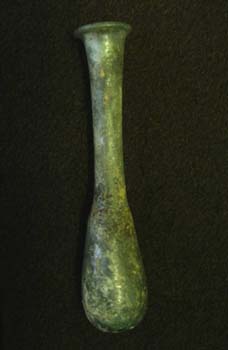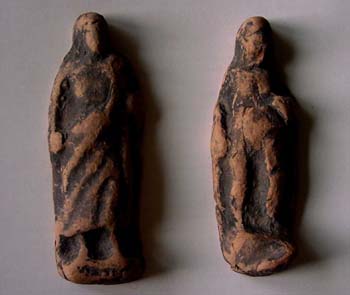 |
| Trier, about 200 AD. |
Medicines were stored in pots of various kinds and shipped. Thus, the preparation "Lykion" was packed in small, cup-like wells made of clay, occasionally also of lead, which each held a few milliliters. Some of the containers bear the name Lykion, others an alepsis head or an Apollo tripod symbolizing the medical content.
Other medicines were filled into vials, with the contents probably being read on the label on the closure or on an attached label. Since the glasses are not inscribed, they can only be identified as medication bottles in combination with the excavated pieces.
In Rome, glass was used as a material for medicine and cosmetic vessels, after the secret of its production had gradually come to Europe via Syria and the Phoenicians. In the 2nd century BC Chr. Glass blowing was invented.
It presents a 132 mm high salve vessel excavated in Trier, a so-called "balsamarium" with a slightly flattened bottom. This form of glass container was very common - far too common to be medication bottles.
Several vials, very similar to the vial shown here, are dispensed as a medical vial in the book "The Collection" by B. Olonetzky, Thieme-Verlag 1980, p. 88). The so-called "medicinal bottles", however, are in the vast majority of cases so-called "lacrimalia" - bottles in which the bereaved catch their tears in order to put them in the grave of the dead person as proof of their deeply felt grief.
All the stories and paraphrases for a funeral ritual in which the Romans put a perfume bottle next to the embalmed body of their dead before the grave was sealed ...
Peter Ustinov as "Nero" in the movie "Quo Vadis": when he crushed a tear, he called for his tear glass to catch the tear ...
Such bottles were also found in Luxembourg: "Roman coins were found at the" Halerbach "in the early 19th century, and in 1859 other coins were discovered, as well as two "urns ", two teardrops and two" copper vases ": Nero, Titus 'and Constantius I mentions' (Weiller 1972, 366, No. 158, Carte Arch. Lux. 12, 1980, 44; Publ. Section Hist. Inst. Luxembourg 3, 1847, 190). Nothing prevented the Roman doctor or pharmacist from selling his sacks in the same kind of vials!
|






